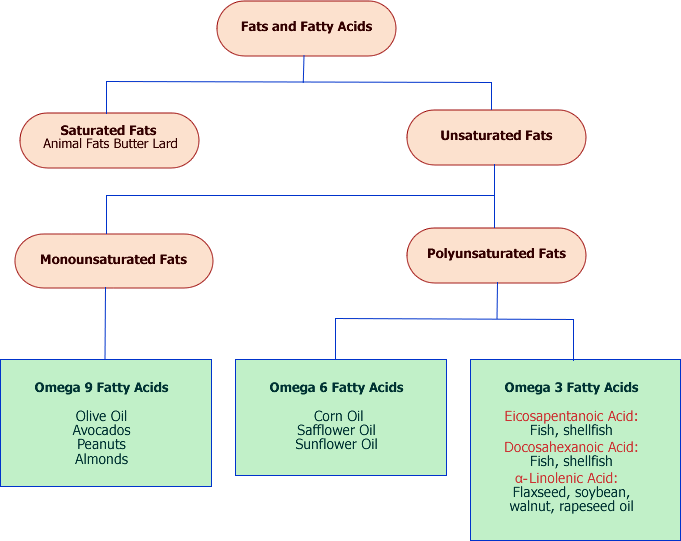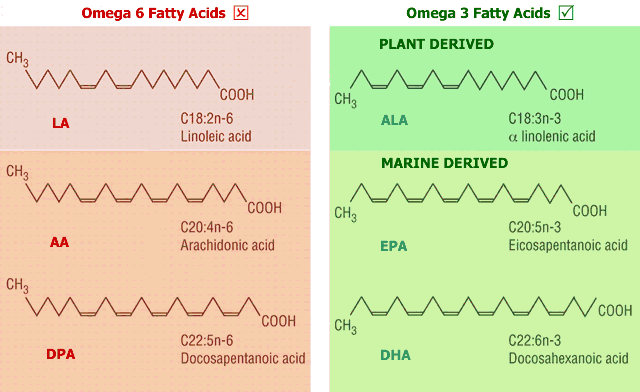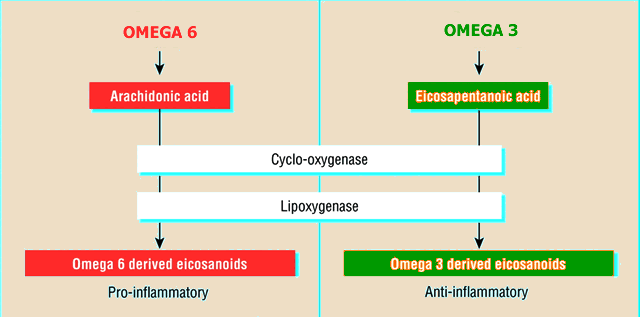 |
||||||||||
Date: January 23, 2025
by Chaya Venkat

You have heard of saturated fats (not good for you), and poly unsaturated fats (also called poly unsaturated fatty acids, generally good for you). Now you have to draw a further distinction between the types of Poly-Unsaturated Fatty Acids (PUFA). Some are very good for you, while some are not only not good for you in large amounts, they can be the cause of many of our modern ailments. Specifically, the wrong type of PUFA can aggravate cardiac disease, autoimmune and chronic inflammation diseases such as multiple sclerosis (MS), lupus, type-1 diabetes, psoriasis, rheumatoid arthritis, yes, even cancer. The research in this area is so compelling that even the FDA is finally getting out there with some concrete guidelines. Read on, many of the benefits to be gained by getting the right mix of PUFAs is directly applicable to us as CLL patients. Indeed, some of the recommendations reviewed in this article may be the simplest, cheapest, low risk, low toxicity things you can do that may make a significant difference in how CLL plays out in your case, in what kind of response you get to therapy, and in how much hassle you get from related problems such as autoimmune disease. Did I say there was no free lunch? This comes close.
There are two distinct groups of poly unsaturated fats (also called poly unsaturated fatty acids). One group is called omega-6 acids and the other group is called omega-3 acids. It is now pretty well established that man evolved on a diet with roughly equal amount of omega-6 and omega-3 fatty acids. Unfortunately, today this ratio for the food we eat is anywhere from 10 to 25 times as much omega-6 acids, compared to omega-3 acids. Western diets are so deficient in omega 3 fatty acids, and so abundant in omega-6 acids, relative to what is good for our bodies, that a significant health crisis has emerged as a consequence.
This important ratio is out of balance in most of our diets because of the change in our eating patterns, as well as changes in food production technology. Omega-6 fatty acids account for the majority of polyunsaturated fatty acids (PUFA) in the food supply. They are the predominant PUFA in all diets, especially Western diets, where most of the fat comes from grain-based oils (corn oil and sunflower oil) or oils from meat (lard). Omega-3 fatty acids, by contrast, are mainly present in cold water fish, and in some oils derived from seeds such as flax seed oil. Not all fish have equal amounts of omega-3 oils - I doubt "fish fingers" (fried in corn oil, no doubt) qualify as health food. Sorry, you guys who fancy fish and chips.
Here are some names and abbreviations you will see as you dig into this whole business of PUFA. The major omega-6 acids are linoleic acid (LA) and arachidonic acid (AA). The principal omega-3 acids are eicosapentanoic acid (EPA) and docosahexanoic acid (DHA), both from cold water "fatty" fish, and last but not least, alpha linolenic acid (ALA). There is another omega-6 acid that is actually beneficial, called gamma linolenic acid (GLA), that we will discuss in another article. I will be using these abbreviations all through this review - you can always scroll up and see which one is which if you get confused. This is the bullet point to remember: LA and AA are omega-6 acids, we get too much of them already. What we need more of are omega-3 acids EPA and DHA from fish oil, and ALA from fish oil as well as flax seed. Before you go from one end of the pendulum's arc to the other extreme, let me hasten to add both omega-3 and omega-6 are important components of practically all cell membranes. It is just that we are overdosing on omega-6 and not getting enough omega-3. Omega-3 and omega-6 fatty acids are not inter-convertible in the human body. When diets are supplemented with omega-3 fatty acids, the latter partially replace the omega-6 fatty acids in the membranes of practically all cells (red blood cells, platelets, cells lining your mouth and gut, monocytes, lymphocytes, granulocytes, nerve cells, retinal cells in your eyes, liver cells and even brain cells). Therefore, getting the right amount of each group of PUFAs influences just about every major organ and system in your body.
General Categories of Fats and Fatty Acids

The Polyunsaturated Fatty Acids

The first evidence of the important role of dietary intake of omega-3 acids in diseases due to chronic inflammation was derived from epidemiological observations. In a population of Greenland Eskimos compared with gender- and age-matched groups living in Denmark, the Eskimos (who lived almost exclusively on a daily diet of cold water fatty fish of various kinds, and therefore got a lot of omega-3 acids) had a low incidence of autoimmune disorders such as psoriasis, asthma and type-1 diabetes, and a complete absence of multiple sclerosis. Most of these diseases are characterized by inappropriate activation of T cells resulting in inflammation of and ultimately destruction of host tissues. Traditional Japanese people have a high dietary intake of long chain omega-3 acids as well, from seafood. Not coincidentally, according to many researchers, they also have a low incidence of myocardial infarction and chronic inflammatory or autoimmune disorders, when compared to Japanese people who have adopted Westernized dietary habits.
We have discussed the role played by chronic inflammation in CLL in earlier articles. If you have not read these, I strongly urge you to do so: Chronic Inflammation and What You Can Do About It, Role of Pulmonary Inflammation in CLL. Left untreated, chronic pulmonary inflammation can put you in the hospital and pneumonia is the most common cause of death in CLL patients. It is thought that competition between the omega-6 and omega-3 fatty acids occurs in prostaglandin formation. EPA, an omega-3 fatty acid for example, competes with AA, an omega-6 fatty acid, for prostaglandin and leukotriene synthesis. When we eat fish or fish oil, the EPA and DHA from fish or fish oil lead to decreased production of the prostaglandin E2 and a decrease in leukotriene B4 formation. This has the effect of decreasing overall inflammation, and making leukocytes less sticky and less able to migrate into the lymph nodes and bone marrow.
In recent months we have all watched with fascination as the car wrecks of Vioxx and Celebrex played out on our TV screens. For a number of years, both of these selective cyclo-oxygenase-2 (Cox-2) inhibitors were touted as miracle drugs that helped arthritis sufferers. There were tantalizing leads that suppressing Cox-2 had the beneficial effect of suppressing inflammation, which in turn helped control cancers of various kinds. Recent findings have put a damper on some of these hopes. We now learn that daily large doses of both of these drugs can cause a higher risk of heart problems. Although common NSAIDs such as aspirin can also inhibit COX (both Cox-1 and Cox-2) and are potent anti-inflammatory agents, chronic use of high doses of aspirin and the like can also have serious adverse effects such as GI tract bleeding. Increasing the intake of omega-3 fatty acids while decreasing the omega-6 fatty acids in the diet has some of the same beneficial effects as Cox suppression. Patients with rheumatoid arthritis and asthma have shown significant improvements upon eating roughly equal amounts of omega-3 and omega-6 fatty acids in their diet.
The PUFA Derivatives

Review Article from Journal of the American College of Nutrition (full-text PDF)
J Am Coll Nutr. 2025 Dec;21(6):495-505.
Omega-3 fatty acids in inflammation and autoimmune diseases.
Simopoulos AP.
The Center for Genetics, Nutrition and Health, Washington, DC
Among the fatty acids, it is the omega-3 polyunsaturated fatty acids (PUFA) which possess the most potent immunomodulatory activities, and among the omega-3 PUFA, those from fish oil-eicosapentaenoic acid (EPA) and docosahexaenoic acid (DHA)--are more biologically potent than alpha-linolenic acid (ALA). Some of the effects of omega-3 PUFA are brought about by modulation of the amount and types of eicosanoids made, and other effects are elicited by eicosanoid-independent mechanisms, including actions upon intracellular signaling pathways, transcription factor activity and gene expression. Animal experiments and clinical intervention studies indicate that omega-3 fatty acids have anti-inflammatory properties and, therefore, might be useful in the management of inflammatory and autoimmune diseases. Coronary heart disease, major depression, aging and cancer are characterized by an increased level of interleukin 1 (IL-1), a proinflammatory cytokine. Similarly, arthritis, Crohn's disease, ulcerative colitis and lupus erythematosis are autoimmune diseases characterized by a high level of IL-1 and the proinflammatory leukotriene LTB(4) produced by omega-6 fatty acids. There have been a number of clinical trials assessing the benefits of dietary supplementation with fish oils in several inflammatory and autoimmune diseases in humans, including rheumatoid arthritis, Crohn's disease, ulcerative colitis, psoriasis, lupus erythematosus, multiple sclerosis and migraine headaches. Many of the placebo-controlled trials of fish oil in chronic inflammatory diseases reveal significant benefit, including decreased disease activity and a lowered use of anti-inflammatory drugs.
PMID: 12480795
____________
Omega-3 fatty acids and inflammation
Mori TA, Beilin LJ.
School of Medicine and Pharmacology--Royal Perth Hospital Unit, The University of Western Australia, Perth, Western Australia 6847, Australia.
Dietary omega-3 (n-3) fatty acids have a variety of anti-inflammatory and immune-modulating effects that may be of relevance to atherosclerosis and its clinical manifestations of myocardial infarction, sudden death, and stroke. The n-3 fatty acids that appear to be most potent in this respect are the long-chain polyunsaturates derived from marine oils, namely eicosapentaenoic acid (EPA) and docosahexaenoic acid (DHA), and this review is restricted to these substances. A variety of biologic effects of EPA and DHA have been demonstrated from feeding studies with fish or fish oil supplements in humans and animals. These include effects on triglycerides, high-density lipoprotein cholesterol, platelet function, endothelial and vascular function, blood pressure, cardiac excitability, measures of oxidative stress, pro- and anti-inflammatory cytokines, and immune function. Epidemiologic studies provide evidence for a beneficial effect of n-3 fatty acids on manifestations of coronary heart disease and ischemic stroke, whereas
randomized, controlled, clinical feeding trials support this, particularly with respect to sudden cardiac death in patients with established disease. Clinically important anti-inflammatory effects in man are further suggested by trials demonstrating benefits of n-3 fatty acids in rheumatoid arthritis, psoriasis, asthma, and inflammatory bowel disorders. Given the evidence relating progression of atherosclerosis to chronic inflammation, the n-3 fatty acids may play an important role via modulation of the inflammatory processes.
PMID: 15485592
____________
Animal and human epidemiologic studies indicate that the ratio of omega-3 to omega-6 fatty acids in the diet is particularly important to the reduction of cancer risk. Do remember that it is not really the amount of omega-3 fats you consume that matters, it is the ratio of omega-3 to omega-6 fatty acids in the diet that is important. Several studies have shown, for example, that the risk of breast and prostate cancer decreases sharply when we eat roughly equal amount of the two types of PUFAs.
How do omega-3 fats help reduce cancer risk? As you should know by now "apoptosis" is programmed cell death, and normal cells are very obedient in quietly committing suicide when it is their time to do so. However, apoptotic pathways are frequently disrupted in cancers, including CLL. This means that CLL cells hang around too long, do not die on command. This is one of the reasons why they accumulate in such large numbers in your body. Anything we can do to re-train them to die on command is going to help the process of controlling the disease, slow down the its progression. Among the reasons for this malfunction in the apoptosis pathway is increased COX-2 expression, over-the-top angiogenesis and activation of the NF-kB pathway, all of which make the cells more resistant to death signals, as well as increase the rate at which the cancer cells proliferate. Among the beneficial things that omega-3 fats do for us is block NF-kB and COX-2 activation, which in turn would restore apoptosis and reduce proliferation. An important gene of the Bcl-2 family can block apoptosis in CLL cells. DHA from fish oil has been reported to inactivate Bcl-2 and increase apoptosis.
Yet another important mechanism by which omega-3 fats play a role as adjuvants to cancer therapy depends on their ability to generate reactive oxygen species (ROS). This is an important subject all on its own, and I would like to take a rain check today in order to do justice to it at a later date. If you are curious about the role played by ROS in cancer cell kill, you might get your motor running by reading an earlier article on Mitochondria (Target Mitochondrion). If you type the key words "Omega-3" "PUFA" and "Cancer therapy" into the PubMed search engine, you will get several hundred hits, giving you an idea of the importance of this area of research.
Over the last decade we have been taught to incorporate more heart-healthy fats in our diet, decrease our use of saturated fatty acids (Lard, butter fat, coconut oil etc) and substitute in their place safflower, corn and soybean oils for frying and baking uses. True, these vegetable oils contain much less of the bad saturated fats, but they also contain a very high amount of omega-6 and very little omega-3 fatty acids. This is not good, as we are just beginning to find out. Getting back to the drawing board, the use of canola (or olive oil as a second choice) instead of safflower, corn or soybean oil for frying and baking would reduce the consumption of omega-6 fatty acids. In addition, canola oil includes a significant amount of the good omega-3 fatty acids. Bottom line, the guidelines are shaking out like this: consumption of several servings per week of fatty, cold-water fish (see list below), switching to canola oil for daily cooking and baking, and perhaps a good supplement of fish oil to bring in additional amounts of DHA and EPA omega-3 fatty acids to the diet.
Article from Journal of Nutrition (Full-text PDF)
J Nutr. 2025 Nov;132(11 Suppl):3508S-3512S.
Omega-3 fatty acids to augment cancer therapy.
Hardman WE.
Pennington Biomedical Research Center, Louisiana State University, Baton Rouge, LA
The results of animal studies have demonstrated that the consumption of omega-3 fatty acids can slow the growth of cancer xenografts, increase the efficacy of chemotherapy and reduce the side effects of the chemotherapy or of the cancer. Molecular mechanisms postulated to contribute to the multiple benefits of omega-3 fatty acids include 1) suppressing the expression of cyclooxygenase-2 in tumors, thus decreasing proliferation of cancer cells and reducing angiogenesis in the tumor; 2) decreasing the expression of AP-1 and ras, two oncogenes implicated in tumor promotion; 3) inducing differentiation of cancer cells; 4) suppressing nuclear factor-kappaB activation and bcl-2 expression, thus allowing apoptosis of cancer cells; and 5) reducing cancer-induced cachexia. It seems reasonable to assume that after appropriate cancer therapy, consumption of omega-3 fatty acids might slow or stop the growth of metastatic cancer cells, increase longevity of cancer patients and improve their quality of life.
PMID: 12421878
____________
Article from Journal of Nutrition (Full-text PDF)
J Nutr. 2025 Dec;134(12 Suppl):3427S-3430S
(n-3) fatty acids and cancer therapy.
Hardman WE.
Pennington Biomedical Research Center, Louisiana State University, Baton Rouge, LA
Supplementing the diet of tumor-bearing mice or rats with oils containing (n-3) (omega-3) or with purified (n-3) fatty acids has slowed the growth of various types of cancers, including lung, colon, mammary, and prostate. The efficacy of cancer chemotherapy drugs such as doxorubicin, epirubicin, CPT-11, 5-fluorouracil, and tamoxifen, and of radiation therapy has been improved when the diet included (n-3) fatty acids. Some potential mechanisms for the activity of (n-3) fatty acids against cancer include modulation of eicosanoid production and inflammation, angiogenesis, proliferation, susceptibility for apoptosis, and estrogen signaling. In humans, (n-3) fatty acids have also been used to suppress cancer-associated cachexia and to improve the quality of life. In one study, the response to chemotherapy therapy was better in breast cancer patients with higher levels of (n-3) fatty acids in adipose tissue [indicating past consumption of (n-3) fatty acids] than in patients with lower levels of (n-3) fatty acids.
Thus, in combination with standard treatments, supplementing the diet with (n-3) fatty acids may be a nontoxic means to improve cancer treatment outcomes and may slow or prevent recurrence of cancer. Used alone, an (n-3) supplement may be a useful alternative therapy for patients who are not candidates for standard toxic cancer therapies.
PMID: 15570049
____________
 OK, now that we know omega-3 fatty acids are good for us, the next practical question is how much to take. Remember, too much of a good thing is not necessarily better. This is particularly true for CLL patients, who may have problems with low platelets that expose them to risk of easy bleeding. There is some research that shows excessive amounts of omega-3 acids may make bleeding problems worse. If your platelet counts are on the low side, I strongly urge you to consult with your physician before you embark on any heavy duty supplementation or dietary modification. Here is what the American Heart Association has to say about the level of omega-3 fatty acids you should have as part of a healthy diet, the recommendations are given below as an exact quote. This 2025 article is very detailed, and the full text is available free of charge. You have absolutely no excuse for not clicking on the this link to a full-text PDF version of the article from Circulation, the journal of the American Heart Association.
OK, now that we know omega-3 fatty acids are good for us, the next practical question is how much to take. Remember, too much of a good thing is not necessarily better. This is particularly true for CLL patients, who may have problems with low platelets that expose them to risk of easy bleeding. There is some research that shows excessive amounts of omega-3 acids may make bleeding problems worse. If your platelet counts are on the low side, I strongly urge you to consult with your physician before you embark on any heavy duty supplementation or dietary modification. Here is what the American Heart Association has to say about the level of omega-3 fatty acids you should have as part of a healthy diet, the recommendations are given below as an exact quote. This 2025 article is very detailed, and the full text is available free of charge. You have absolutely no excuse for not clicking on the this link to a full-text PDF version of the article from Circulation, the journal of the American Heart Association.
American Heart Association’s dietary guidelines recommend that healthy adults eat at least two servings of fish per week, particularly fish such as mackerel, lake trout, herring, sardines, albacore tuna and salmon. These fish contain two omega-3 PUFAs eicosapentaenoic and docosahexaenoic acids (EPA and DHA). A third kind of omega-3 fatty acid alpha-linolenic acid (ALA), comes from soybeans, canola, walnut and flaxseed and oils made from those beans, nuts and seeds. It is thought to be less potent than EPA and DHA from fish oils. Getting enough EPA and DHA from diet alone can be a little tough, unless you are really fond of eating fish. People who have elevated triglycerides may need as much as 2 to 4 grams of EPA and DHA per day, and the only reasonable method of getting this much EPA and DHA is by taking a fish oil supplement. Patients taking more than 3 grams of omega-3 fatty acids from supplements should do so only under a physician’s care. The FDA has noted that high intakes could cause excessive bleeding in some people, and taking lots of omega-3 fatty acids without cutting back on some of the not so good omega-6 fatty acids can lead to increased LDL cholesterol, especially if you also happen to have high levels of unhealthy triglycerides to begin with. Moral of the story: the idea is not to add a lot more omega-3 oils to your diet without changing anything else, the idea is to cut back on some of the omega-6 fats and substitute omega-3 fats in their place. In practical terms, you might do this by switching from corn oil or olive oil to canola oil, which has much higher ALA. It might mean passing on meat and potatoes in favor of a nice piece of grilled salmon and side of veggies. And to get sufficient amount of EPA and DHA, you may have to resort to a supplement. Be warned: fish oil capsules can cause upset an stomach in some patients but taking them at meal time with food seems to make for less problems. Some patients also complain of fishy aftertaste. Oh well. Here is a table of the relative risk of various side effects.
| Dosage | GI Upset | Clinical Bleeding | Fishy Aftertaste | Worsening Glycemia* | Rise in LDL-C** |
| Up to 1 gm/day | Very low | Very Low | Low | Very Low | Very Low |
| Up to 3 gm/day | Moderate | Very Low | Moderate | Low | Moderate |
| > 3gm/day | Moderate | Low | Likely | Moderate | Likey |
| * Usually only in patients with impaired glucose tolerance and diabetes ** Usually only in patients with hypertriglyceridemia. |
|||||
| Source | Saturated | PUFAs | Monounsaturated | |
| n-6 (LA) | n-3 (ALA) | |||
| Canola | 7 | 21 | 11 | 61 |
| Safflower | 10 | 76 | 7 | 16 |
| Corn | 13 | 57 | 1 | 29 |
| Olive | 15 | 9 | 1 | 75 |
| Soybean | 15 | 54 | 8 | 23 |
| Peanut | 19 | 33 | 1 | 48 |
| Lard | 43 | 54 | 1 | 2 |
| Palm | 51 | 10 | 1 | 39 |
| Butterfat | 68 | 3 | 1 | 28 |
| Coconut | 91 | 2 | 0 | 7 |
Type in "Fish Oil" into Google search box and you will get thousands upon thousands of hits. I am not about to recommend a brand name to you, that is your business. But I will recommend that you do your homework, read the fine print on the label, and use a reputable company. Fish oil capsules should be sold in dark colored bottles since they decompose upon exposure to light for long periods of time. I also suggest you don't buy a year's worth of fish oil capsules at one time; and you should look to buy from a store that does brisk business so that you are not likely to get stuck with something that has been sitting on the shelf from a couple of years ago. "Buyer beware" is a good thing to remember when shopping for food supplements. Some of the vendors make extraordinary claims for their products, you need to have a good BS detector to be able to walk away from such products. You need to look for the EPA and DHA content of the fish oil, this should be clearly spelled out on the bottle label. Typically, the garden variety fish oil capsules from Walgreen's weigh 1 gram (1,000 milligrams), and contain 180 milligrams of EPA and 120 milligrams of DHA for a total of 300 milligrams of omega-3 PUFAs. It is equally important to make sure that the capsules have no other goodies, such as vitamins A, E and C. It is possible to overdose quite quickly on Vitamins A and E, in your effort to get sufficient EPA and DHA. Look for fish oil that has none of this stuff added in. Furthermore, all three of these vitamins (A, E and C) are strong anti-oxidants, and they will interfere with the generation of ROS and killing of cancer cells. As I said above, ROS, fish oil, and cancer therapy is a whole interesting subject by itself, we will get to it in the next few days. Bottom line, look for plain vanilla fish oil, nothing extra added to it. Not only will you have a better handle on what you are getting, it will be lighter on your wallet too.
If your preference is to increase omega-3 acids by making changes in your diet as opposed to swallowing a capsule, you need to eat fish a lot more than you have been. Here is a list of fish that have high omega-3 fat content. The table gives grams of omega-3 PUFAs per 6-ounce serving.
Mackerel, Atlantic |
4.4 |
|
Mackerel, King |
3.7 |
|
Herring, Pacific |
3.1 |
|
Herring, Atlantic |
2.9 |
|
Tuna, Bluefin |
2.7 |
|
Sablefish |
2.6 |
|
Salmon, Chinook |
2.6 |
|
Sturgeon, Atlantic |
2.6 |
|
Tuna, Albacore |
2.6 |
|
Whitefish, lake |
2.6 |
|
Anchovies, European |
2.4 |
|
Salmon, Atlantic |
2.4 |
|
Salmon, Sockeye |
2.2 |
|
Bluefish |
2.0 |
|
Mullet |
1.9 |
|
Salmon, Coho |
1.7 |
|
Salmon, Pink |
1.7 |
Nearly all fish and shellfish contain traces of methylmercury, a form of mercury found in water that can be harmful. This has been a huge concern in recent years and caused many people to stop eating fish altogether. Mercury can be especially toxic to unborn babies and young children whose nervous systems are still developing. For middle-aged and older men, and postmenopausal women, the benefits of eating fish within the established guidelines far outweigh the risks, in my opinion.
I would expect (but cannot guarantee) that fish oil capsules from reputable companies have been purified sufficiently to have very little mercury contamination. You might want to check this out, make sure it is indeed the case. If familial CLL is something you worry about (Not the Worst Day of Your Life), and you want to do something that may protect your kids down the road, I suggest you discuss with your pediatrician the value of incorporating fish oil capsules in the daily nutrition of your children. Switching from omega-6-laden corn oil to omega-3-rich canola oil is a simple thing to do. Eating less pre-packaged food and more fresh cooked food with a variety of vegetables, fruits, whole grains will help balance the PUFAs as well. Those of you on extreme diets such as the Atkins diet will have to figure things out for yourselves. The idea is to make sure you keep the omega-3 and omega-6 PUFAs in roughly equal amounts.
We have all heard the cliché, "you are what you eat". This is particularly true with respect to omega-3 oils. I am putting my money where my mouth is on this one. I have been a life long vegetarian, mostly due to esthetic reasons. It is hard for me to break that tradition this late in my life. I do not have CLL, but starting last week I have added two capsules of fish oil (total omega-3 of 600 milligrams per day) to my diet. I have also switched from using olive oil in my cooking to the omega-3-rich canola oil. My husband PC, the carnivore in the family and the one with CLL, eats grilled salmon or tuna several times a week, and takes a lot more fish oil capsules. One side effect I noticed right away, increasing fish oil consumption makes for much softer, smoother and more supple skin! What is not to like, right?

 Enter Keywords: |
———
Disclaimer: The content of this website is intended for information only and is NOT meant to be medical advice. Please be sure to consult and follow the advice of your doctors on all medical matters.
Copyright Notice:
Copyright © 2025-2007 CLL Topics, Inc. All Rights Reserved.
All materials contained on this site are protected by United States copyright law and may not be reproduced, distributed, transmitted, displayed, published or broadcast without the prior written permission of CLL Topics, Inc. You may not alter or remove any trademark, copyright or other notice from copies of the content.
However, you may download and print material from CLLTopics.org exclusively for your personal, noncommercial use.
———
